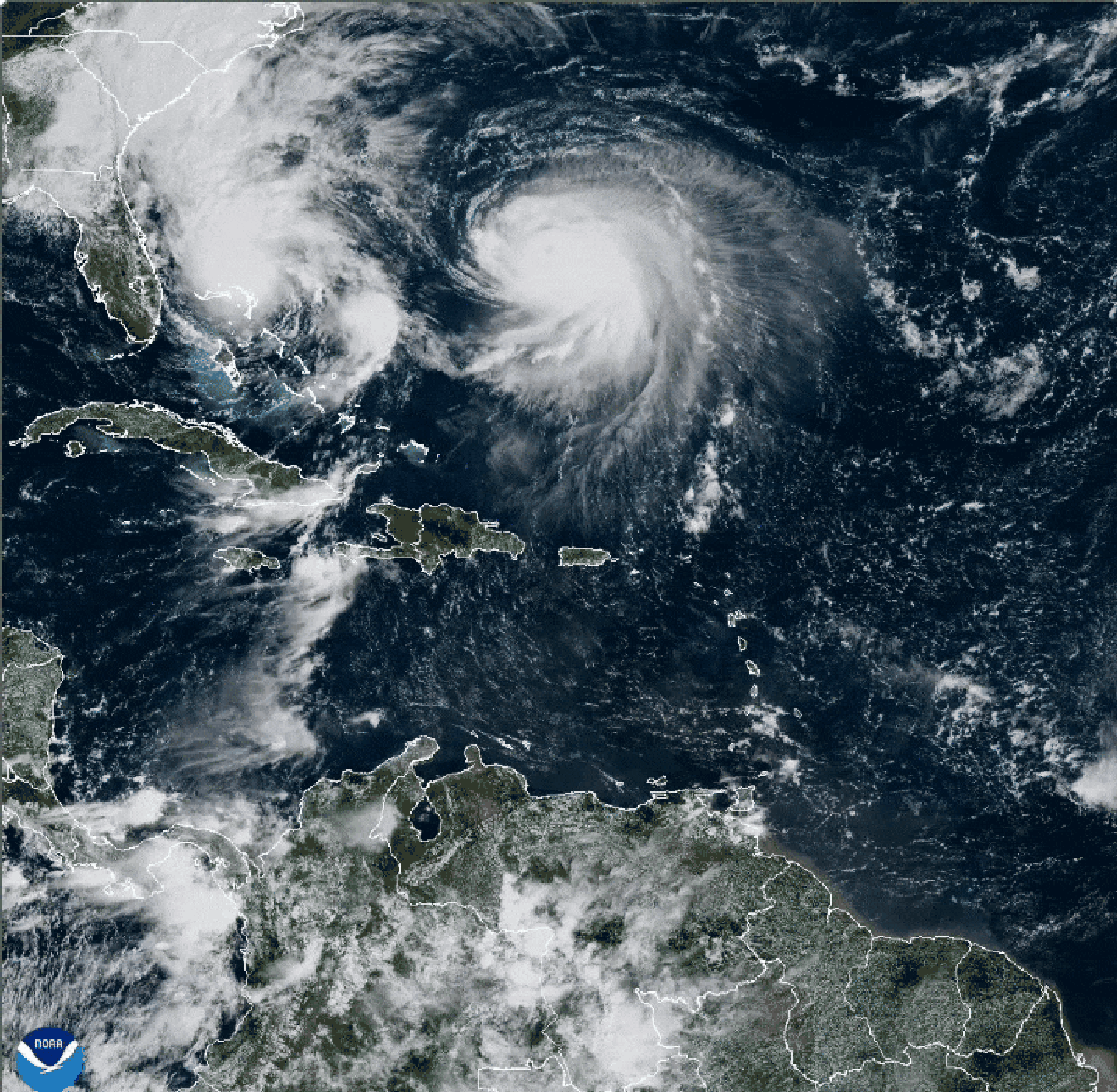How Hurricane Humberto Is Pulling Tropical Storm Imelda Away from the U.S.
In a version of the Fujiwhara effect, Hurricane Humberto is pulling Tropical Storm Imelda eastward and away from the U.S.
NOAA/NESDIS/STAR
The U.S. Southeast will likely avoid the worst effects from Tropical Storm Imelda—all thanks to another tropical cyclone.
Imelda and Hurricane Humberto have been churning over the northeastern Caribbean, between the Bahamas and Bermuda, for several days. Last Friday the forecasts were highly uncertain about Imelda’s path and future strength: the possibilities ranged from the storm making landfall in the Carolinas, which would bring torrential rain and floods, to it not making landfall in the U.S. The latter now looks to be the likely scenario. That’s because Imelda dawdled in its development while Humberto quickly exploded into a major hurricane, which has influenced how much the two storms “feel” each other—essentially a flavor of what is called the Fujiwhara effect. (The East Coast will still feel rip currents from Imelda, though, and the storm could pose a threat to Bermuda as it takes a sharp eastward turn in the coming days.)
READ MORE: Hurricane Science Has a Lot of Jargon—Here’s What It All Means
If you’re enjoying this article, consider supporting our award-winning journalism by subscribing. By purchasing a subscription you are helping to ensure the future of impactful stories about the discoveries and ideas shaping our world today.
But Imelda was very slow to become organized into a full tropical storm, so it has crept northward slowly, leaving it in the perfect spot to feel the pull of Humberto. “Essentially what happens is: you’ve got [westerly] winds around Humberto from the cyclone, and Imelda just gets caught up in that and follows behind,” Gerard says.*
READ MORE: How to Decode a Hurricane Forecast
Imelda and Humberto aren’t close enough for that to happen, but the Fujiwhara effect can take other forms once the distance between two storms is within about 800 miles, and each can “feel” the other, McNoldy says. “The centers of Imelda and Humberto are now just 600 miles apart, and their outer circulations are already communicating,” McNoldy wrote in an e-mail to Scientific American. “Model forecasts bring them even closer together in the coming couple of days.”
Humberto is weakening the quasi-permanent ridge over Bermuda and opening up a path to pull Imelda behind it. Essentially, “Imelda is caught up in Humberto’s wake,” Gerard says.
Though this reduces the risks to the U.S., the interaction could mean that Imelda will pose more of a direct threat to Bermuda than Humberto will; the latter will travel a few hundred miles to the north of the islands.
*Editor’s Note (9/29/25): This sentence was edited after posting to correct Alan Gerard’s comment about westerly winds around Humberto.
Andrea Thompson is a senior editor covering the environment, energy and earth sciences. She has been covering these issues for 16 years. Prior to joining Scientific American, she was a senior writer covering climate science at Climate Central and a reporter and editor at Live Science, where she primarily covered earth science and the environment. She has moderated panels, including as part of the United Nations Sustainable Development Media Zone, and appeared in radio and television interviews on major networks. She holds a graduate degree in science, health and environmental reporting from New York University, as well as a B.S. and an M.S. in atmospheric chemistry from the Georgia Institute of Technology. Follow Thompson on Bluesky @andreatweather.bsky.social
If you enjoyed this article, I’d like to ask for your support. Scientific American has served as an advocate for science and industry for 180 years, and right now may be the most critical moment in that two-century history.
I’ve been a Scientific American subscriber since I was 12 years old, and it helped shape the way I look at the world. SciAm always educates and delights me, and inspires a sense of awe for our vast, beautiful universe. I hope it does that for you, too.
If you , you help ensure that our coverage is centered on meaningful research and discovery; that we have the resources to report on the decisions that threaten labs across the U.S.; and that we support both budding and working scientists at a time when the value of science itself too often goes unrecognized.
In return, you get essential news, captivating podcasts, brilliant infographics, , must-watch videos, challenging games, and the science world’s best writing and reporting. You can even gift someone a subscription.
There has never been a more important time for us to stand up and show why science matters. I hope you’ll support us in that mission.
Thank you,
David M. Ewalt, Editor in Chief, Scientific American
Source: www.scientificamerican.com
